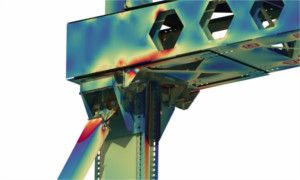Consists of modeling products and systems in a virtual environment, with the aim of finding and solving possible structural or performance problems (or existing problems). In this way, the aim is to predict how a product will react to different physical effects such as forces, vibration, fatigue, heat, movement, fluid flow, etc.
FEA is the practical application of the finite element method (FEM analysis), which is used to mathematically model and numerically solve complex structural, fluid and multiphysical problems. Finite element calculation can be used in a wide range of sectors, such as automotive, aeronautics, oil&gas.
At SDEA_Engineering Solutions we use Ansys as a regular work tool for analysis and simulation because it is industry oriented, as well as other similar commercial and non-commercial software.
FEA decomposes a real object into a large number of finite elements. Mathematical equations predict the behaviour of each element. A computer then adds together all the individual behaviours to predict the real behaviour of the object.
The subcategories we work with are:

